Unit 4 Report: Financial and HR in Hospitality Business Toolkit
VerifiedAdded on 2022/11/28
|18
|4766
|342
Report
AI Summary
This report provides a comprehensive overview of key business activities within the hospitality industry, using The Ned Hotel as a case study. It begins with an analysis of financial transactions, including source documents, principles of financial management, and the double-entry bookkeeping system. The report then delves into human resource management, exploring the HR lifecycle stages in the context of a front desk receptionist role, including attraction, recruitment, onboarding, employee development, and performance management. It also examines relevant legislation, such as employment and contract law, and their impact on business decision-making. Furthermore, the report discusses the interrelation between different functional roles in a hospitality organization and various communication methods. The report provides a detailed analysis of costing elements, gross profit margin, and the significance of performance management for the front desk receptionist. The conclusion highlights key takeaways and provides references for further reading.

Unit 4 The
Hospitality
Business
Toolkit
Hospitality
Business
Toolkit
Paraphrase This Document
Need a fresh take? Get an instant paraphrase of this document with our AI Paraphraser
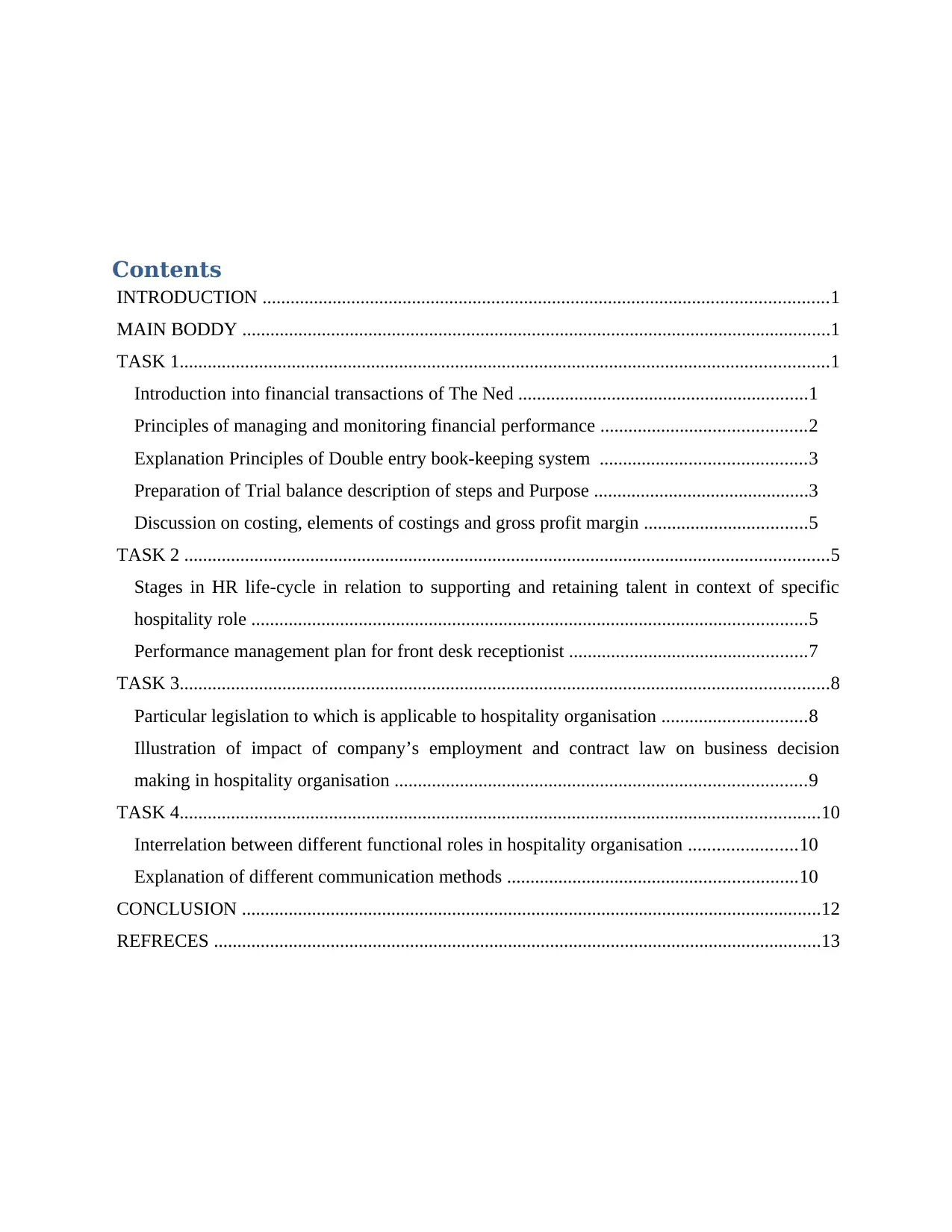
Contents
INTRODUCTION .........................................................................................................................1
MAIN BODDY ..............................................................................................................................1
TASK 1...........................................................................................................................................1
Introduction into financial transactions of The Ned ..............................................................1
Principles of managing and monitoring financial performance ............................................2
Explanation Principles of Double entry book-keeping system ............................................3
Preparation of Trial balance description of steps and Purpose ..............................................3
Discussion on costing, elements of costings and gross profit margin ...................................5
TASK 2 ..........................................................................................................................................5
Stages in HR life-cycle in relation to supporting and retaining talent in context of specific
hospitality role .......................................................................................................................5
Performance management plan for front desk receptionist ...................................................7
TASK 3...........................................................................................................................................8
Particular legislation to which is applicable to hospitality organisation ...............................8
Illustration of impact of company’s employment and contract law on business decision
making in hospitality organisation ........................................................................................9
TASK 4.........................................................................................................................................10
Interrelation between different functional roles in hospitality organisation .......................10
Explanation of different communication methods ..............................................................10
CONCLUSION ............................................................................................................................12
REFRECES ..................................................................................................................................13
INTRODUCTION .........................................................................................................................1
MAIN BODDY ..............................................................................................................................1
TASK 1...........................................................................................................................................1
Introduction into financial transactions of The Ned ..............................................................1
Principles of managing and monitoring financial performance ............................................2
Explanation Principles of Double entry book-keeping system ............................................3
Preparation of Trial balance description of steps and Purpose ..............................................3
Discussion on costing, elements of costings and gross profit margin ...................................5
TASK 2 ..........................................................................................................................................5
Stages in HR life-cycle in relation to supporting and retaining talent in context of specific
hospitality role .......................................................................................................................5
Performance management plan for front desk receptionist ...................................................7
TASK 3...........................................................................................................................................8
Particular legislation to which is applicable to hospitality organisation ...............................8
Illustration of impact of company’s employment and contract law on business decision
making in hospitality organisation ........................................................................................9
TASK 4.........................................................................................................................................10
Interrelation between different functional roles in hospitality organisation .......................10
Explanation of different communication methods ..............................................................10
CONCLUSION ............................................................................................................................12
REFRECES ..................................................................................................................................13

⊘ This is a preview!⊘
Do you want full access?
Subscribe today to unlock all pages.

Trusted by 1+ million students worldwide
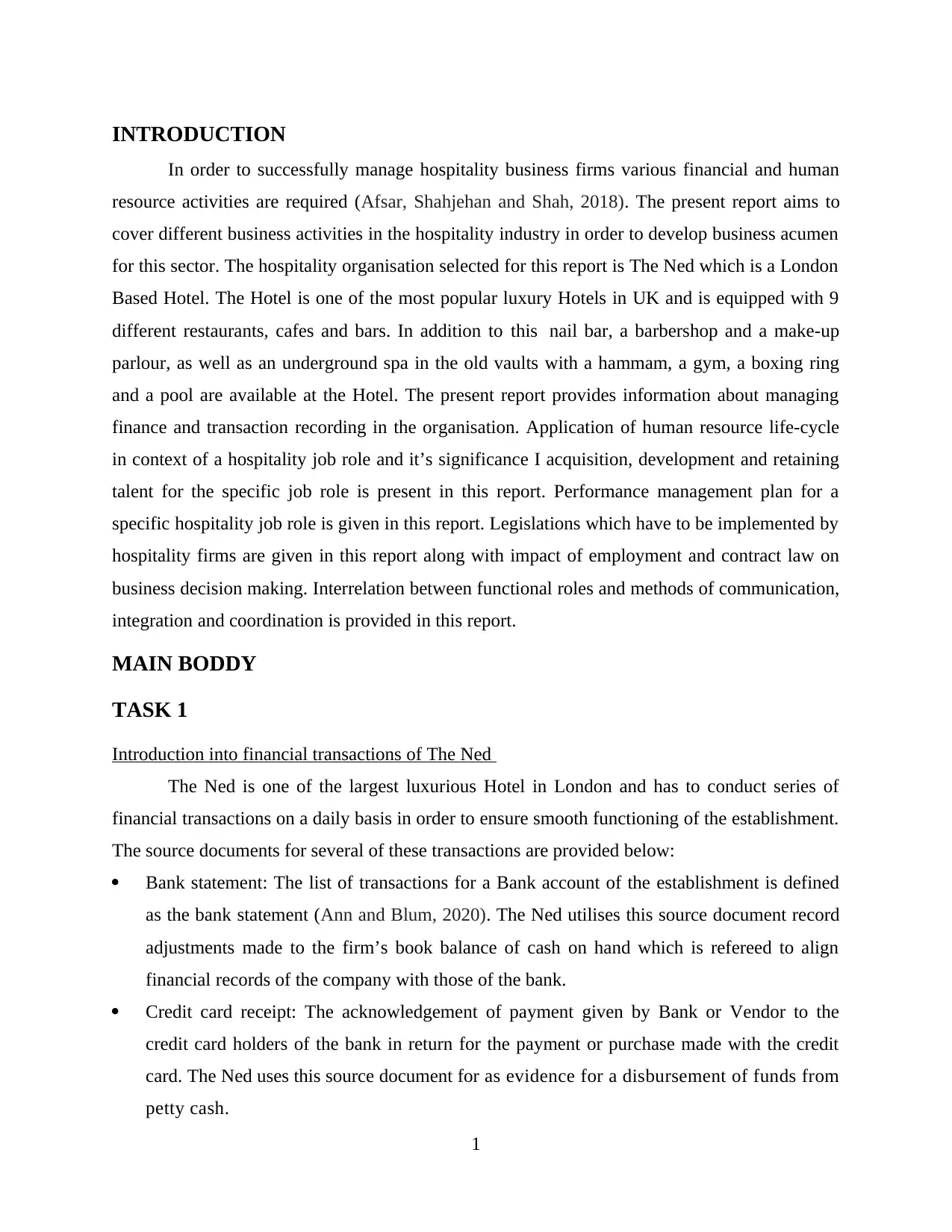
INTRODUCTION
In order to successfully manage hospitality business firms various financial and human
resource activities are required (Afsar, Shahjehan and Shah, 2018). The present report aims to
cover different business activities in the hospitality industry in order to develop business acumen
for this sector. The hospitality organisation selected for this report is The Ned which is a London
Based Hotel. The Hotel is one of the most popular luxury Hotels in UK and is equipped with 9
different restaurants, cafes and bars. In addition to this nail bar, a barbershop and a make-up
parlour, as well as an underground spa in the old vaults with a hammam, a gym, a boxing ring
and a pool are available at the Hotel. The present report provides information about managing
finance and transaction recording in the organisation. Application of human resource life-cycle
in context of a hospitality job role and it’s significance I acquisition, development and retaining
talent for the specific job role is present in this report. Performance management plan for a
specific hospitality job role is given in this report. Legislations which have to be implemented by
hospitality firms are given in this report along with impact of employment and contract law on
business decision making. Interrelation between functional roles and methods of communication,
integration and coordination is provided in this report.
MAIN BODDY
TASK 1
Introduction into financial transactions of The Ned
The Ned is one of the largest luxurious Hotel in London and has to conduct series of
financial transactions on a daily basis in order to ensure smooth functioning of the establishment.
The source documents for several of these transactions are provided below:
Bank statement: The list of transactions for a Bank account of the establishment is defined
as the bank statement (Ann and Blum, 2020). The Ned utilises this source document record
adjustments made to the firm’s book balance of cash on hand which is refereed to align
financial records of the company with those of the bank.
Credit card receipt: The acknowledgement of payment given by Bank or Vendor to the
credit card holders of the bank in return for the payment or purchase made with the credit
card. The Ned uses this source document for as evidence for a disbursement of funds from
petty cash.
1
In order to successfully manage hospitality business firms various financial and human
resource activities are required (Afsar, Shahjehan and Shah, 2018). The present report aims to
cover different business activities in the hospitality industry in order to develop business acumen
for this sector. The hospitality organisation selected for this report is The Ned which is a London
Based Hotel. The Hotel is one of the most popular luxury Hotels in UK and is equipped with 9
different restaurants, cafes and bars. In addition to this nail bar, a barbershop and a make-up
parlour, as well as an underground spa in the old vaults with a hammam, a gym, a boxing ring
and a pool are available at the Hotel. The present report provides information about managing
finance and transaction recording in the organisation. Application of human resource life-cycle
in context of a hospitality job role and it’s significance I acquisition, development and retaining
talent for the specific job role is present in this report. Performance management plan for a
specific hospitality job role is given in this report. Legislations which have to be implemented by
hospitality firms are given in this report along with impact of employment and contract law on
business decision making. Interrelation between functional roles and methods of communication,
integration and coordination is provided in this report.
MAIN BODDY
TASK 1
Introduction into financial transactions of The Ned
The Ned is one of the largest luxurious Hotel in London and has to conduct series of
financial transactions on a daily basis in order to ensure smooth functioning of the establishment.
The source documents for several of these transactions are provided below:
Bank statement: The list of transactions for a Bank account of the establishment is defined
as the bank statement (Ann and Blum, 2020). The Ned utilises this source document record
adjustments made to the firm’s book balance of cash on hand which is refereed to align
financial records of the company with those of the bank.
Credit card receipt: The acknowledgement of payment given by Bank or Vendor to the
credit card holders of the bank in return for the payment or purchase made with the credit
card. The Ned uses this source document for as evidence for a disbursement of funds from
petty cash.
1
Paraphrase This Document
Need a fresh take? Get an instant paraphrase of this document with our AI Paraphraser
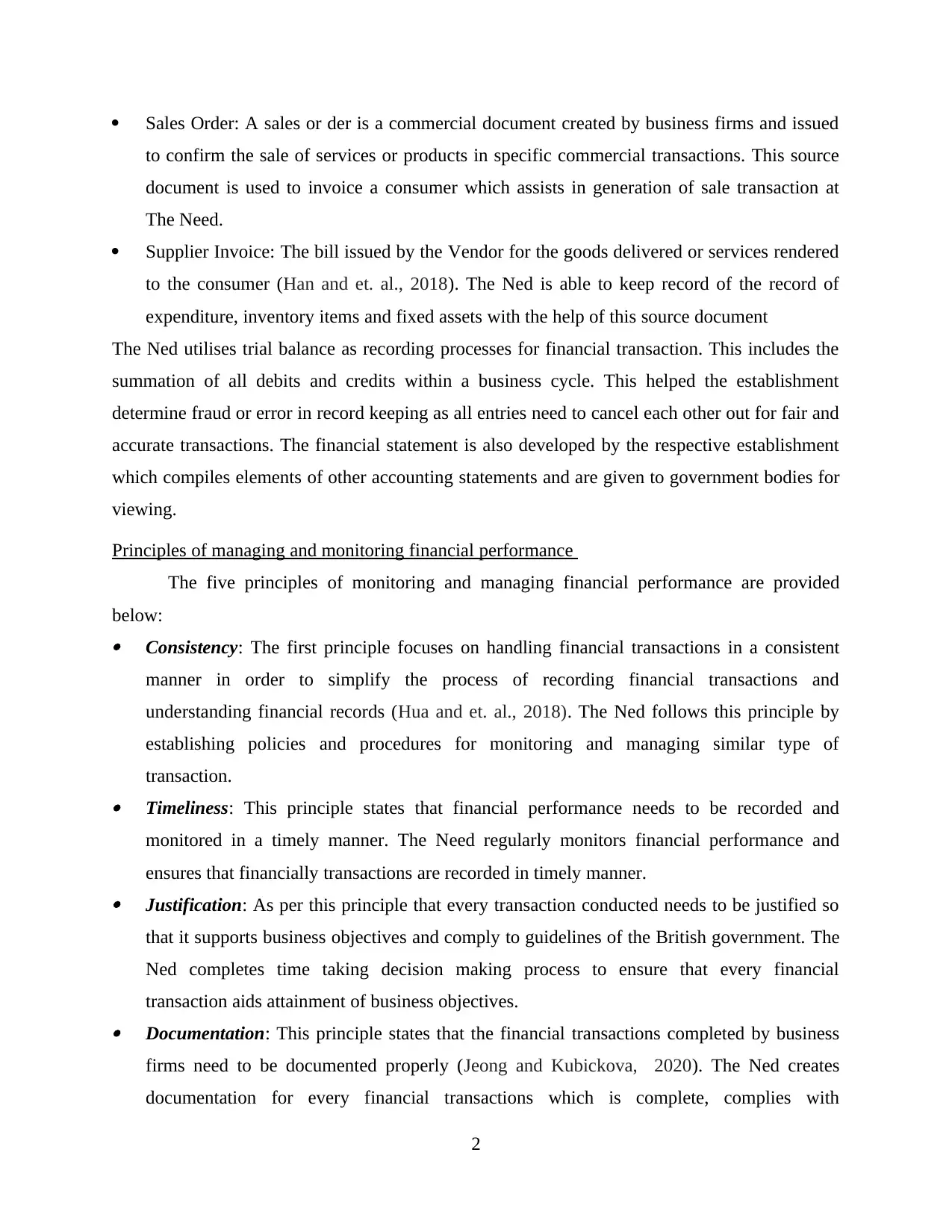
Sales Order: A sales or der is a commercial document created by business firms and issued
to confirm the sale of services or products in specific commercial transactions. This source
document is used to invoice a consumer which assists in generation of sale transaction at
The Need.
Supplier Invoice: The bill issued by the Vendor for the goods delivered or services rendered
to the consumer (Han and et. al., 2018). The Ned is able to keep record of the record of
expenditure, inventory items and fixed assets with the help of this source document
The Ned utilises trial balance as recording processes for financial transaction. This includes the
summation of all debits and credits within a business cycle. This helped the establishment
determine fraud or error in record keeping as all entries need to cancel each other out for fair and
accurate transactions. The financial statement is also developed by the respective establishment
which compiles elements of other accounting statements and are given to government bodies for
viewing.
Principles of managing and monitoring financial performance
The five principles of monitoring and managing financial performance are provided
below: Consistency: The first principle focuses on handling financial transactions in a consistent
manner in order to simplify the process of recording financial transactions and
understanding financial records (Hua and et. al., 2018). The Ned follows this principle by
establishing policies and procedures for monitoring and managing similar type of
transaction. Timeliness: This principle states that financial performance needs to be recorded and
monitored in a timely manner. The Need regularly monitors financial performance and
ensures that financially transactions are recorded in timely manner. Justification: As per this principle that every transaction conducted needs to be justified so
that it supports business objectives and comply to guidelines of the British government. The
Ned completes time taking decision making process to ensure that every financial
transaction aids attainment of business objectives. Documentation: This principle states that the financial transactions completed by business
firms need to be documented properly (Jeong and Kubickova, 2020). The Ned creates
documentation for every financial transactions which is complete, complies with
2
to confirm the sale of services or products in specific commercial transactions. This source
document is used to invoice a consumer which assists in generation of sale transaction at
The Need.
Supplier Invoice: The bill issued by the Vendor for the goods delivered or services rendered
to the consumer (Han and et. al., 2018). The Ned is able to keep record of the record of
expenditure, inventory items and fixed assets with the help of this source document
The Ned utilises trial balance as recording processes for financial transaction. This includes the
summation of all debits and credits within a business cycle. This helped the establishment
determine fraud or error in record keeping as all entries need to cancel each other out for fair and
accurate transactions. The financial statement is also developed by the respective establishment
which compiles elements of other accounting statements and are given to government bodies for
viewing.
Principles of managing and monitoring financial performance
The five principles of monitoring and managing financial performance are provided
below: Consistency: The first principle focuses on handling financial transactions in a consistent
manner in order to simplify the process of recording financial transactions and
understanding financial records (Hua and et. al., 2018). The Ned follows this principle by
establishing policies and procedures for monitoring and managing similar type of
transaction. Timeliness: This principle states that financial performance needs to be recorded and
monitored in a timely manner. The Need regularly monitors financial performance and
ensures that financially transactions are recorded in timely manner. Justification: As per this principle that every transaction conducted needs to be justified so
that it supports business objectives and comply to guidelines of the British government. The
Ned completes time taking decision making process to ensure that every financial
transaction aids attainment of business objectives. Documentation: This principle states that the financial transactions completed by business
firms need to be documented properly (Jeong and Kubickova, 2020). The Ned creates
documentation for every financial transactions which is complete, complies with
2
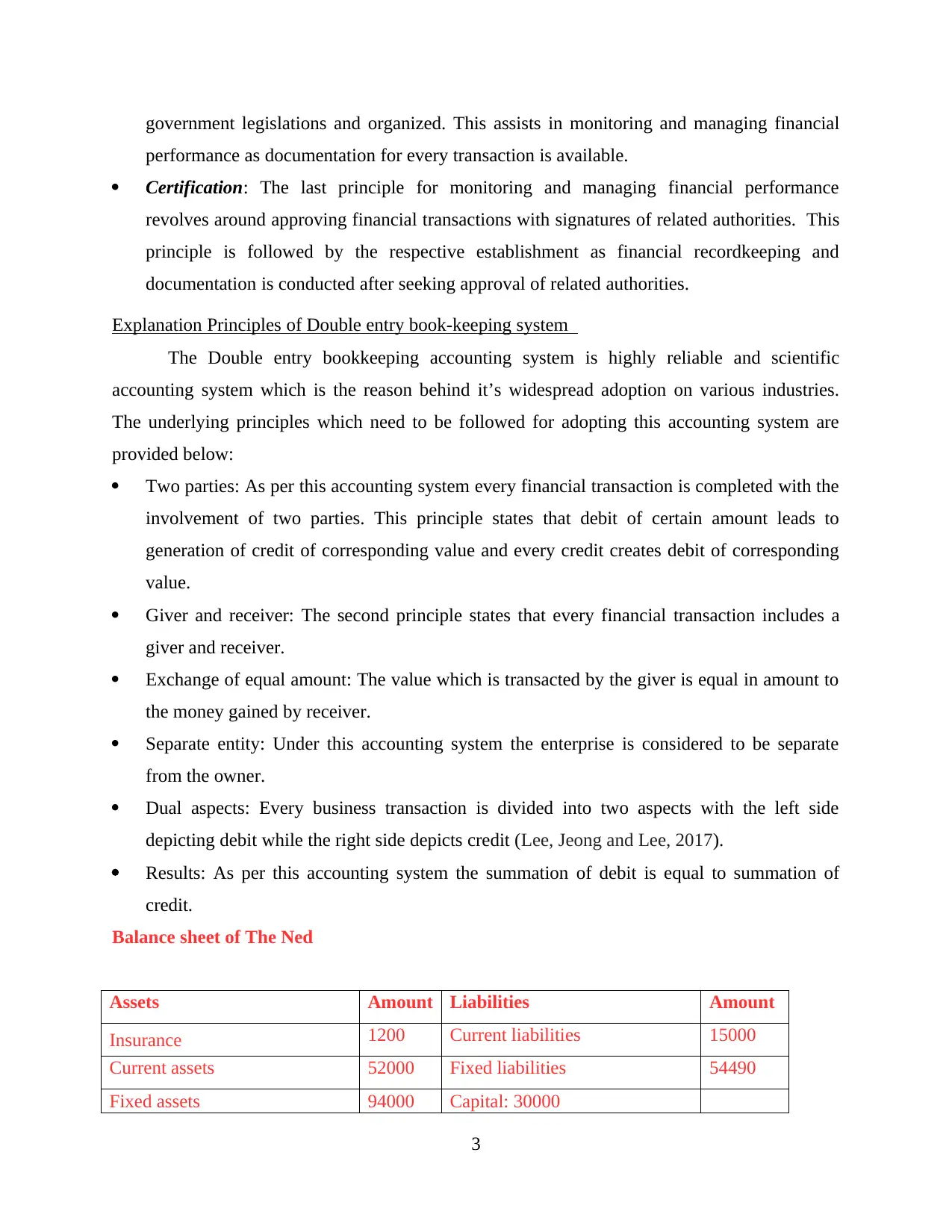
government legislations and organized. This assists in monitoring and managing financial
performance as documentation for every transaction is available.
Certification: The last principle for monitoring and managing financial performance
revolves around approving financial transactions with signatures of related authorities. This
principle is followed by the respective establishment as financial recordkeeping and
documentation is conducted after seeking approval of related authorities.
Explanation Principles of Double entry book-keeping system
The Double entry bookkeeping accounting system is highly reliable and scientific
accounting system which is the reason behind it’s widespread adoption on various industries.
The underlying principles which need to be followed for adopting this accounting system are
provided below:
Two parties: As per this accounting system every financial transaction is completed with the
involvement of two parties. This principle states that debit of certain amount leads to
generation of credit of corresponding value and every credit creates debit of corresponding
value.
Giver and receiver: The second principle states that every financial transaction includes a
giver and receiver.
Exchange of equal amount: The value which is transacted by the giver is equal in amount to
the money gained by receiver.
Separate entity: Under this accounting system the enterprise is considered to be separate
from the owner.
Dual aspects: Every business transaction is divided into two aspects with the left side
depicting debit while the right side depicts credit (Lee, Jeong and Lee, 2017).
Results: As per this accounting system the summation of debit is equal to summation of
credit.
Balance sheet of The Ned
Assets Amount Liabilities Amount
Insurance 1200 Current liabilities 15000
Current assets 52000 Fixed liabilities 54490
Fixed assets 94000 Capital: 30000
3
performance as documentation for every transaction is available.
Certification: The last principle for monitoring and managing financial performance
revolves around approving financial transactions with signatures of related authorities. This
principle is followed by the respective establishment as financial recordkeeping and
documentation is conducted after seeking approval of related authorities.
Explanation Principles of Double entry book-keeping system
The Double entry bookkeeping accounting system is highly reliable and scientific
accounting system which is the reason behind it’s widespread adoption on various industries.
The underlying principles which need to be followed for adopting this accounting system are
provided below:
Two parties: As per this accounting system every financial transaction is completed with the
involvement of two parties. This principle states that debit of certain amount leads to
generation of credit of corresponding value and every credit creates debit of corresponding
value.
Giver and receiver: The second principle states that every financial transaction includes a
giver and receiver.
Exchange of equal amount: The value which is transacted by the giver is equal in amount to
the money gained by receiver.
Separate entity: Under this accounting system the enterprise is considered to be separate
from the owner.
Dual aspects: Every business transaction is divided into two aspects with the left side
depicting debit while the right side depicts credit (Lee, Jeong and Lee, 2017).
Results: As per this accounting system the summation of debit is equal to summation of
credit.
Balance sheet of The Ned
Assets Amount Liabilities Amount
Insurance 1200 Current liabilities 15000
Current assets 52000 Fixed liabilities 54490
Fixed assets 94000 Capital: 30000
3
⊘ This is a preview!⊘
Do you want full access?
Subscribe today to unlock all pages.

Trusted by 1+ million students worldwide
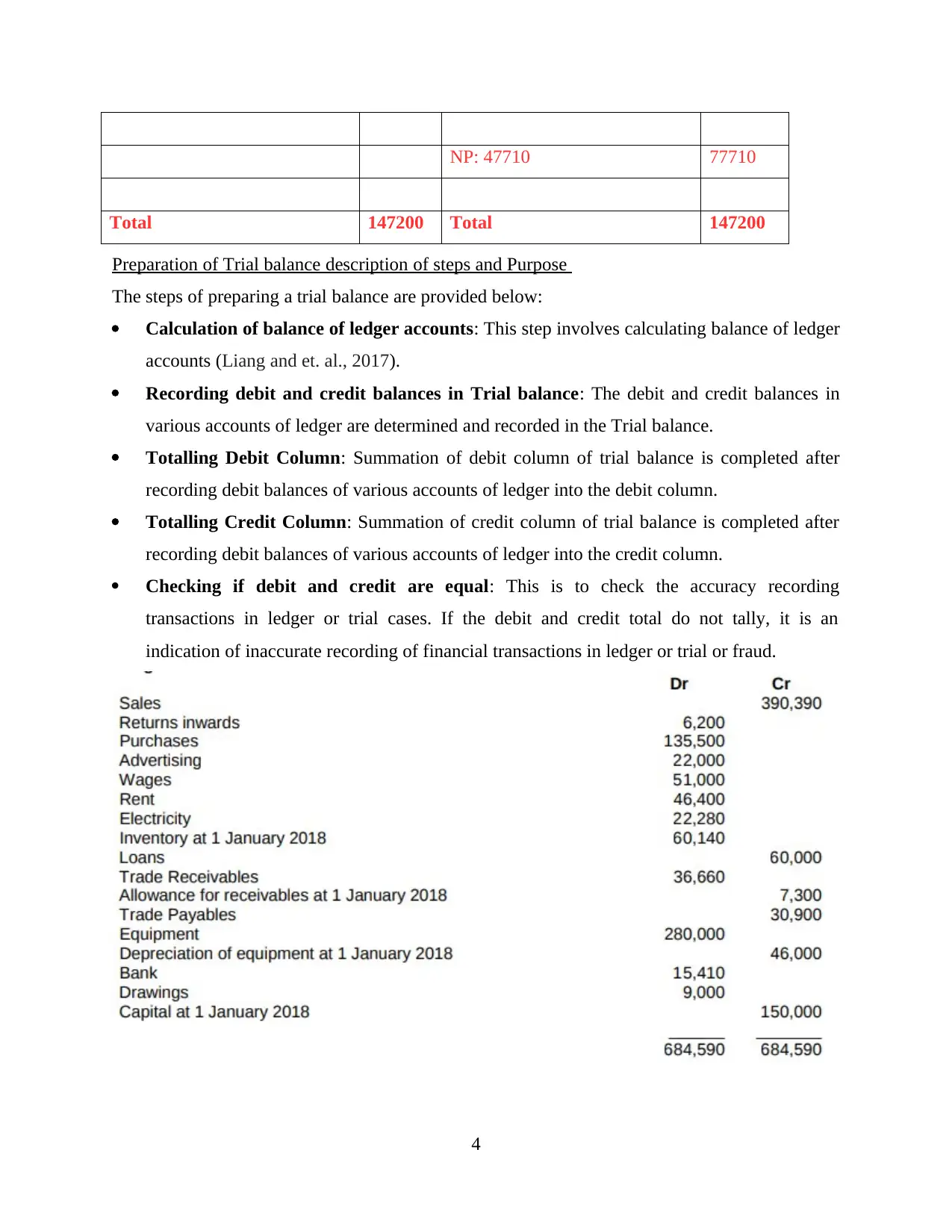
NP: 47710 77710
Total 147200 Total 147200
Preparation of Trial balance description of steps and Purpose
The steps of preparing a trial balance are provided below:
Calculation of balance of ledger accounts: This step involves calculating balance of ledger
accounts (Liang and et. al., 2017).
Recording debit and credit balances in Trial balance: The debit and credit balances in
various accounts of ledger are determined and recorded in the Trial balance.
Totalling Debit Column: Summation of debit column of trial balance is completed after
recording debit balances of various accounts of ledger into the debit column.
Totalling Credit Column: Summation of credit column of trial balance is completed after
recording debit balances of various accounts of ledger into the credit column.
Checking if debit and credit are equal: This is to check the accuracy recording
transactions in ledger or trial cases. If the debit and credit total do not tally, it is an
indication of inaccurate recording of financial transactions in ledger or trial or fraud.
4
Total 147200 Total 147200
Preparation of Trial balance description of steps and Purpose
The steps of preparing a trial balance are provided below:
Calculation of balance of ledger accounts: This step involves calculating balance of ledger
accounts (Liang and et. al., 2017).
Recording debit and credit balances in Trial balance: The debit and credit balances in
various accounts of ledger are determined and recorded in the Trial balance.
Totalling Debit Column: Summation of debit column of trial balance is completed after
recording debit balances of various accounts of ledger into the debit column.
Totalling Credit Column: Summation of credit column of trial balance is completed after
recording debit balances of various accounts of ledger into the credit column.
Checking if debit and credit are equal: This is to check the accuracy recording
transactions in ledger or trial cases. If the debit and credit total do not tally, it is an
indication of inaccurate recording of financial transactions in ledger or trial or fraud.
4
Paraphrase This Document
Need a fresh take? Get an instant paraphrase of this document with our AI Paraphraser
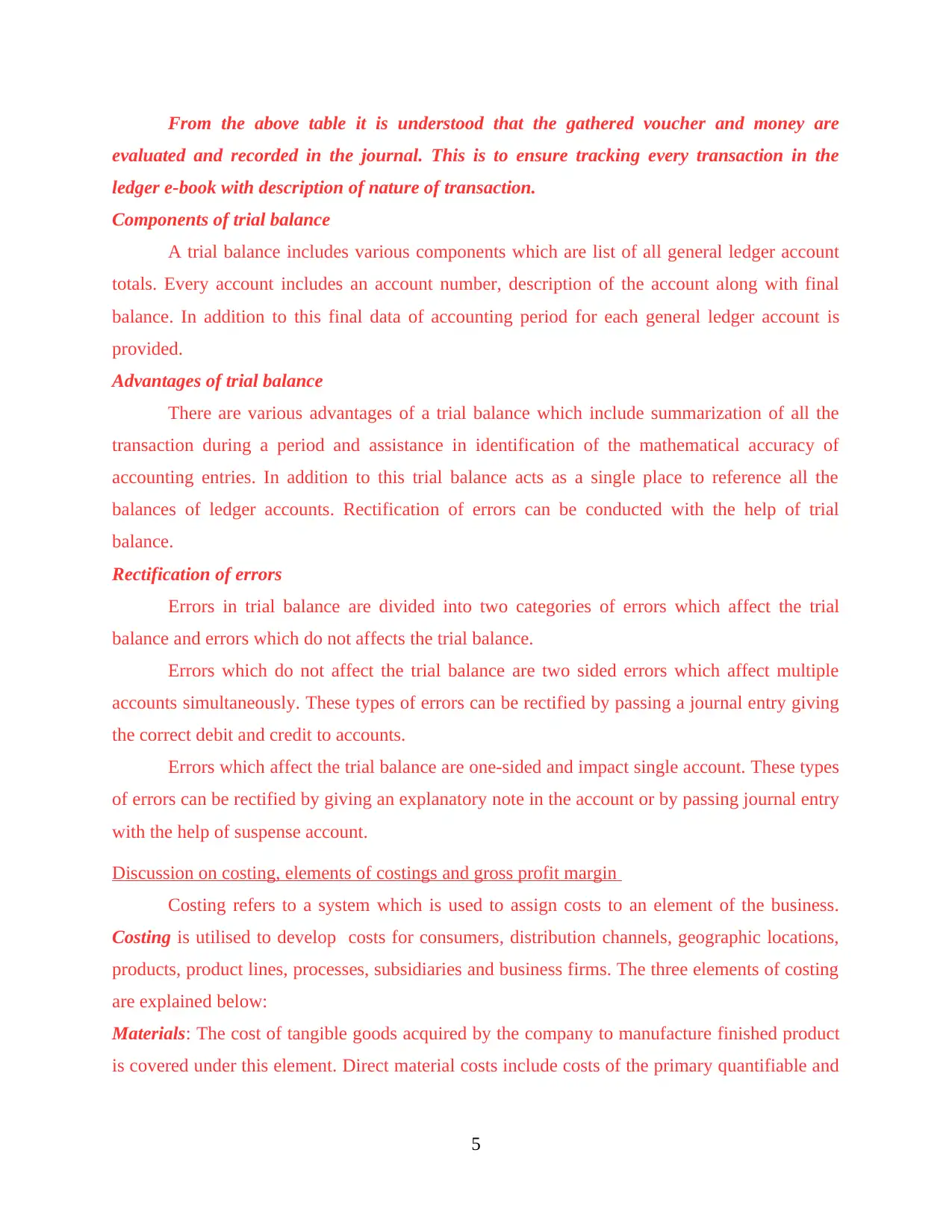
From the above table it is understood that the gathered voucher and money are
evaluated and recorded in the journal. This is to ensure tracking every transaction in the
ledger e-book with description of nature of transaction.
Components of trial balance
A trial balance includes various components which are list of all general ledger account
totals. Every account includes an account number, description of the account along with final
balance. In addition to this final data of accounting period for each general ledger account is
provided.
Advantages of trial balance
There are various advantages of a trial balance which include summarization of all the
transaction during a period and assistance in identification of the mathematical accuracy of
accounting entries. In addition to this trial balance acts as a single place to reference all the
balances of ledger accounts. Rectification of errors can be conducted with the help of trial
balance.
Rectification of errors
Errors in trial balance are divided into two categories of errors which affect the trial
balance and errors which do not affects the trial balance.
Errors which do not affect the trial balance are two sided errors which affect multiple
accounts simultaneously. These types of errors can be rectified by passing a journal entry giving
the correct debit and credit to accounts.
Errors which affect the trial balance are one-sided and impact single account. These types
of errors can be rectified by giving an explanatory note in the account or by passing journal entry
with the help of suspense account.
Discussion on costing, elements of costings and gross profit margin
Costing refers to a system which is used to assign costs to an element of the business.
Costing is utilised to develop costs for consumers, distribution channels, geographic locations,
products, product lines, processes, subsidiaries and business firms. The three elements of costing
are explained below:
Materials: The cost of tangible goods acquired by the company to manufacture finished product
is covered under this element. Direct material costs include costs of the primary quantifiable and
5
evaluated and recorded in the journal. This is to ensure tracking every transaction in the
ledger e-book with description of nature of transaction.
Components of trial balance
A trial balance includes various components which are list of all general ledger account
totals. Every account includes an account number, description of the account along with final
balance. In addition to this final data of accounting period for each general ledger account is
provided.
Advantages of trial balance
There are various advantages of a trial balance which include summarization of all the
transaction during a period and assistance in identification of the mathematical accuracy of
accounting entries. In addition to this trial balance acts as a single place to reference all the
balances of ledger accounts. Rectification of errors can be conducted with the help of trial
balance.
Rectification of errors
Errors in trial balance are divided into two categories of errors which affect the trial
balance and errors which do not affects the trial balance.
Errors which do not affect the trial balance are two sided errors which affect multiple
accounts simultaneously. These types of errors can be rectified by passing a journal entry giving
the correct debit and credit to accounts.
Errors which affect the trial balance are one-sided and impact single account. These types
of errors can be rectified by giving an explanatory note in the account or by passing journal entry
with the help of suspense account.
Discussion on costing, elements of costings and gross profit margin
Costing refers to a system which is used to assign costs to an element of the business.
Costing is utilised to develop costs for consumers, distribution channels, geographic locations,
products, product lines, processes, subsidiaries and business firms. The three elements of costing
are explained below:
Materials: The cost of tangible goods acquired by the company to manufacture finished product
is covered under this element. Direct material costs include costs of the primary quantifiable and
5
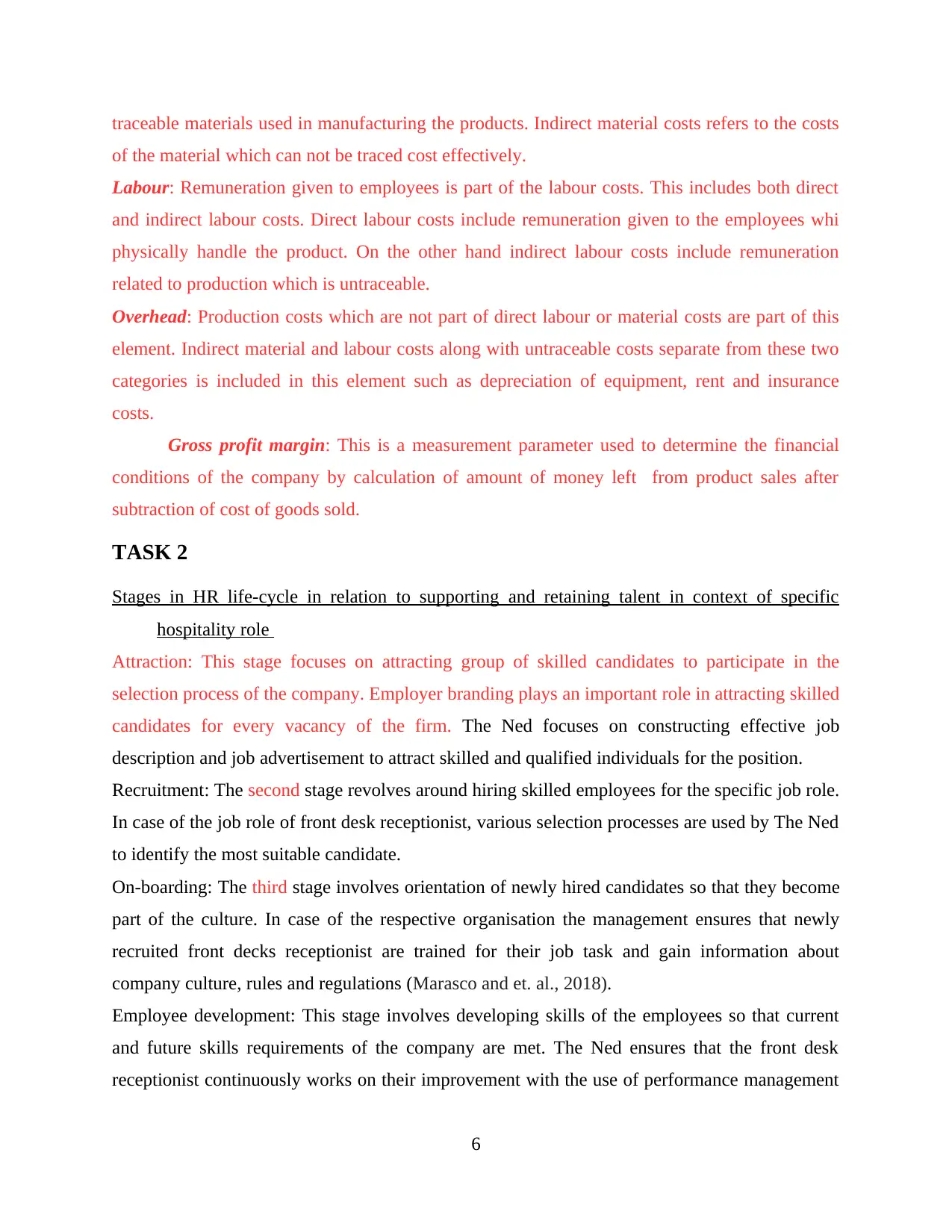
traceable materials used in manufacturing the products. Indirect material costs refers to the costs
of the material which can not be traced cost effectively.
Labour: Remuneration given to employees is part of the labour costs. This includes both direct
and indirect labour costs. Direct labour costs include remuneration given to the employees whi
physically handle the product. On the other hand indirect labour costs include remuneration
related to production which is untraceable.
Overhead: Production costs which are not part of direct labour or material costs are part of this
element. Indirect material and labour costs along with untraceable costs separate from these two
categories is included in this element such as depreciation of equipment, rent and insurance
costs.
Gross profit margin: This is a measurement parameter used to determine the financial
conditions of the company by calculation of amount of money left from product sales after
subtraction of cost of goods sold.
TASK 2
Stages in HR life-cycle in relation to supporting and retaining talent in context of specific
hospitality role
Attraction: This stage focuses on attracting group of skilled candidates to participate in the
selection process of the company. Employer branding plays an important role in attracting skilled
candidates for every vacancy of the firm. The Ned focuses on constructing effective job
description and job advertisement to attract skilled and qualified individuals for the position.
Recruitment: The second stage revolves around hiring skilled employees for the specific job role.
In case of the job role of front desk receptionist, various selection processes are used by The Ned
to identify the most suitable candidate.
On-boarding: The third stage involves orientation of newly hired candidates so that they become
part of the culture. In case of the respective organisation the management ensures that newly
recruited front decks receptionist are trained for their job task and gain information about
company culture, rules and regulations (Marasco and et. al., 2018).
Employee development: This stage involves developing skills of the employees so that current
and future skills requirements of the company are met. The Ned ensures that the front desk
receptionist continuously works on their improvement with the use of performance management
6
of the material which can not be traced cost effectively.
Labour: Remuneration given to employees is part of the labour costs. This includes both direct
and indirect labour costs. Direct labour costs include remuneration given to the employees whi
physically handle the product. On the other hand indirect labour costs include remuneration
related to production which is untraceable.
Overhead: Production costs which are not part of direct labour or material costs are part of this
element. Indirect material and labour costs along with untraceable costs separate from these two
categories is included in this element such as depreciation of equipment, rent and insurance
costs.
Gross profit margin: This is a measurement parameter used to determine the financial
conditions of the company by calculation of amount of money left from product sales after
subtraction of cost of goods sold.
TASK 2
Stages in HR life-cycle in relation to supporting and retaining talent in context of specific
hospitality role
Attraction: This stage focuses on attracting group of skilled candidates to participate in the
selection process of the company. Employer branding plays an important role in attracting skilled
candidates for every vacancy of the firm. The Ned focuses on constructing effective job
description and job advertisement to attract skilled and qualified individuals for the position.
Recruitment: The second stage revolves around hiring skilled employees for the specific job role.
In case of the job role of front desk receptionist, various selection processes are used by The Ned
to identify the most suitable candidate.
On-boarding: The third stage involves orientation of newly hired candidates so that they become
part of the culture. In case of the respective organisation the management ensures that newly
recruited front decks receptionist are trained for their job task and gain information about
company culture, rules and regulations (Marasco and et. al., 2018).
Employee development: This stage involves developing skills of the employees so that current
and future skills requirements of the company are met. The Ned ensures that the front desk
receptionist continuously works on their improvement with the use of performance management
6
⊘ This is a preview!⊘
Do you want full access?
Subscribe today to unlock all pages.

Trusted by 1+ million students worldwide
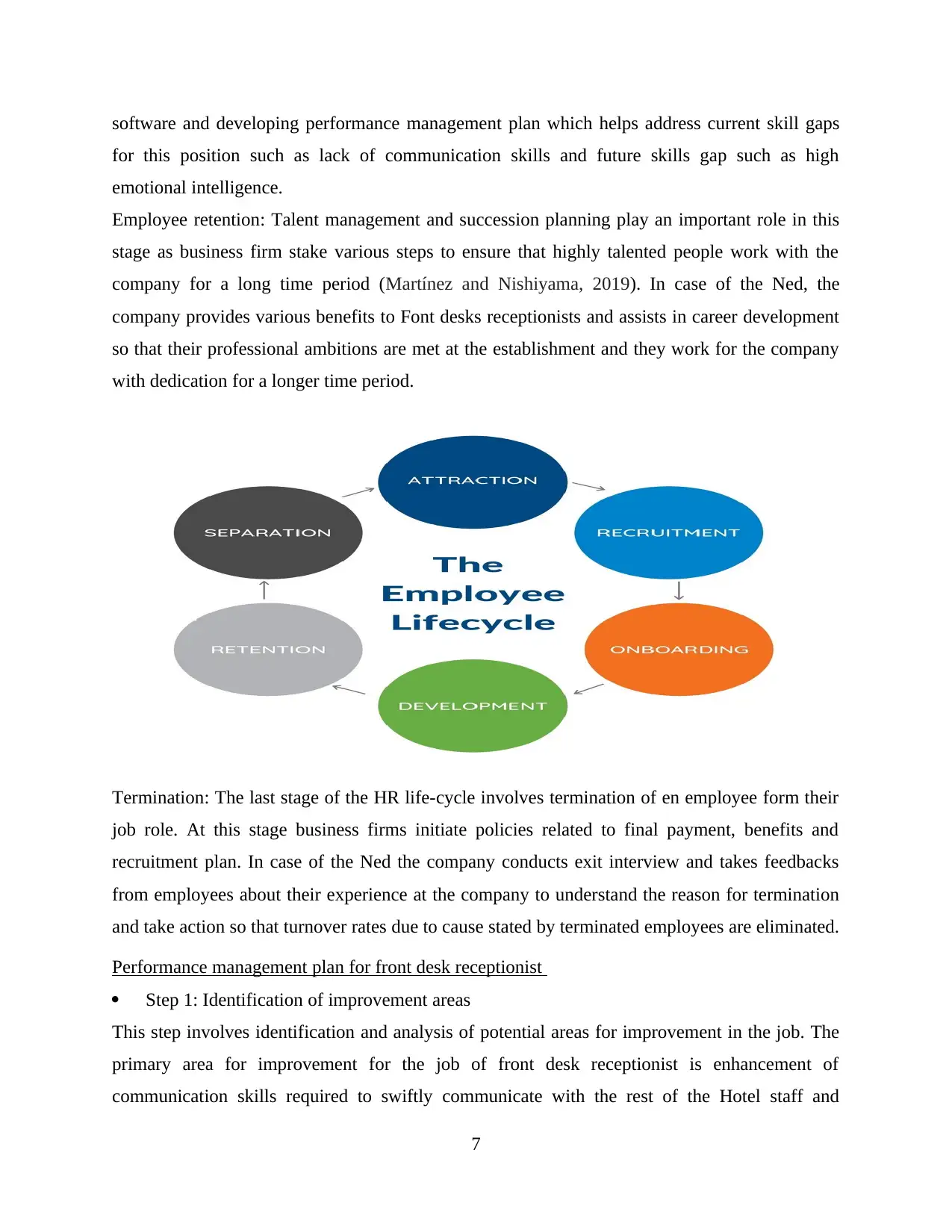
software and developing performance management plan which helps address current skill gaps
for this position such as lack of communication skills and future skills gap such as high
emotional intelligence.
Employee retention: Talent management and succession planning play an important role in this
stage as business firm stake various steps to ensure that highly talented people work with the
company for a long time period (Martínez and Nishiyama, 2019). In case of the Ned, the
company provides various benefits to Font desks receptionists and assists in career development
so that their professional ambitions are met at the establishment and they work for the company
with dedication for a longer time period.
Termination: The last stage of the HR life-cycle involves termination of en employee form their
job role. At this stage business firms initiate policies related to final payment, benefits and
recruitment plan. In case of the Ned the company conducts exit interview and takes feedbacks
from employees about their experience at the company to understand the reason for termination
and take action so that turnover rates due to cause stated by terminated employees are eliminated.
Performance management plan for front desk receptionist
Step 1: Identification of improvement areas
This step involves identification and analysis of potential areas for improvement in the job. The
primary area for improvement for the job of front desk receptionist is enhancement of
communication skills required to swiftly communicate with the rest of the Hotel staff and
7
for this position such as lack of communication skills and future skills gap such as high
emotional intelligence.
Employee retention: Talent management and succession planning play an important role in this
stage as business firm stake various steps to ensure that highly talented people work with the
company for a long time period (Martínez and Nishiyama, 2019). In case of the Ned, the
company provides various benefits to Font desks receptionists and assists in career development
so that their professional ambitions are met at the establishment and they work for the company
with dedication for a longer time period.
Termination: The last stage of the HR life-cycle involves termination of en employee form their
job role. At this stage business firms initiate policies related to final payment, benefits and
recruitment plan. In case of the Ned the company conducts exit interview and takes feedbacks
from employees about their experience at the company to understand the reason for termination
and take action so that turnover rates due to cause stated by terminated employees are eliminated.
Performance management plan for front desk receptionist
Step 1: Identification of improvement areas
This step involves identification and analysis of potential areas for improvement in the job. The
primary area for improvement for the job of front desk receptionist is enhancement of
communication skills required to swiftly communicate with the rest of the Hotel staff and
7
Paraphrase This Document
Need a fresh take? Get an instant paraphrase of this document with our AI Paraphraser
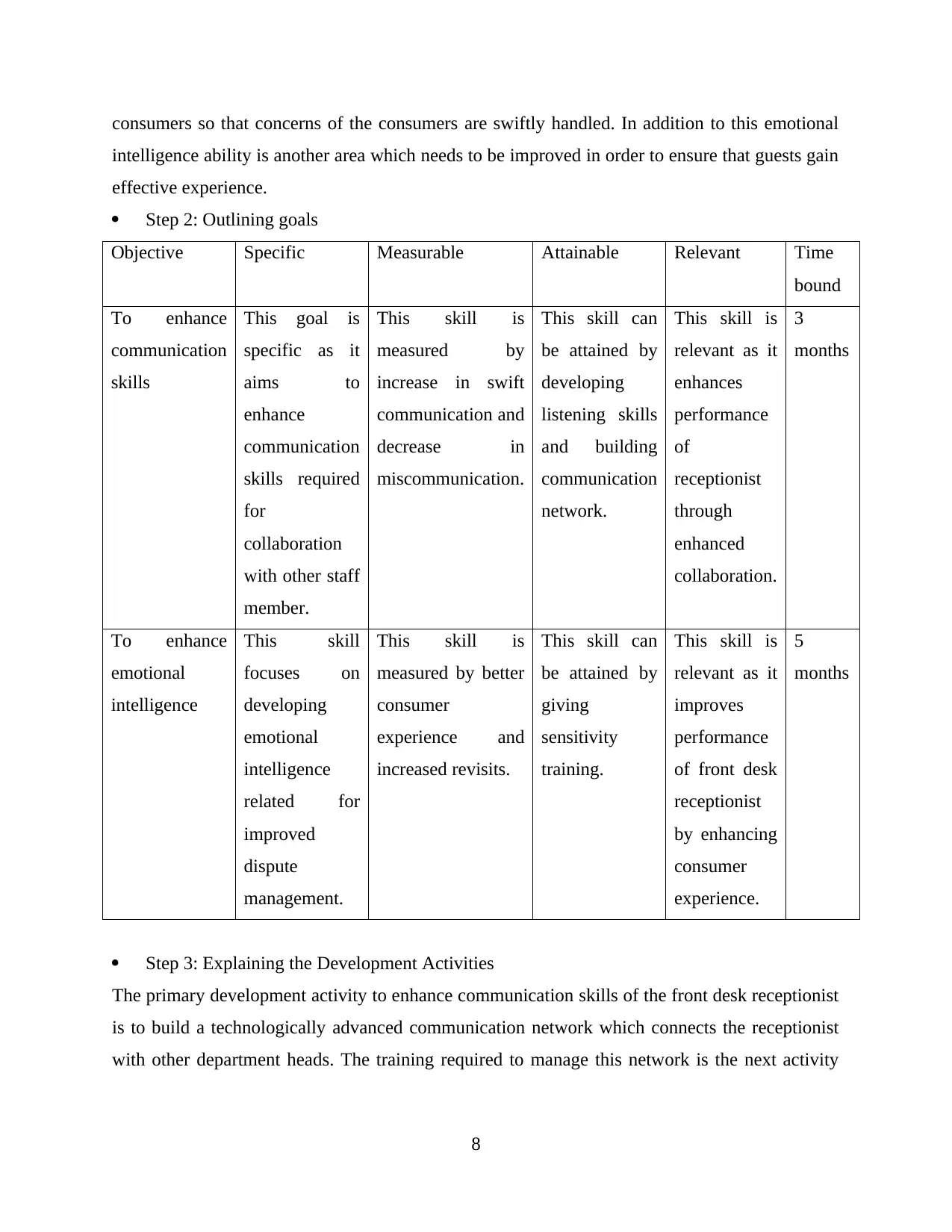
consumers so that concerns of the consumers are swiftly handled. In addition to this emotional
intelligence ability is another area which needs to be improved in order to ensure that guests gain
effective experience.
Step 2: Outlining goals
Objective Specific Measurable Attainable Relevant Time
bound
To enhance
communication
skills
This goal is
specific as it
aims to
enhance
communication
skills required
for
collaboration
with other staff
member.
This skill is
measured by
increase in swift
communication and
decrease in
miscommunication.
This skill can
be attained by
developing
listening skills
and building
communication
network.
This skill is
relevant as it
enhances
performance
of
receptionist
through
enhanced
collaboration.
3
months
To enhance
emotional
intelligence
This skill
focuses on
developing
emotional
intelligence
related for
improved
dispute
management.
This skill is
measured by better
consumer
experience and
increased revisits.
This skill can
be attained by
giving
sensitivity
training.
This skill is
relevant as it
improves
performance
of front desk
receptionist
by enhancing
consumer
experience.
5
months
Step 3: Explaining the Development Activities
The primary development activity to enhance communication skills of the front desk receptionist
is to build a technologically advanced communication network which connects the receptionist
with other department heads. The training required to manage this network is the next activity
8
intelligence ability is another area which needs to be improved in order to ensure that guests gain
effective experience.
Step 2: Outlining goals
Objective Specific Measurable Attainable Relevant Time
bound
To enhance
communication
skills
This goal is
specific as it
aims to
enhance
communication
skills required
for
collaboration
with other staff
member.
This skill is
measured by
increase in swift
communication and
decrease in
miscommunication.
This skill can
be attained by
developing
listening skills
and building
communication
network.
This skill is
relevant as it
enhances
performance
of
receptionist
through
enhanced
collaboration.
3
months
To enhance
emotional
intelligence
This skill
focuses on
developing
emotional
intelligence
related for
improved
dispute
management.
This skill is
measured by better
consumer
experience and
increased revisits.
This skill can
be attained by
giving
sensitivity
training.
This skill is
relevant as it
improves
performance
of front desk
receptionist
by enhancing
consumer
experience.
5
months
Step 3: Explaining the Development Activities
The primary development activity to enhance communication skills of the front desk receptionist
is to build a technologically advanced communication network which connects the receptionist
with other department heads. The training required to manage this network is the next activity
8
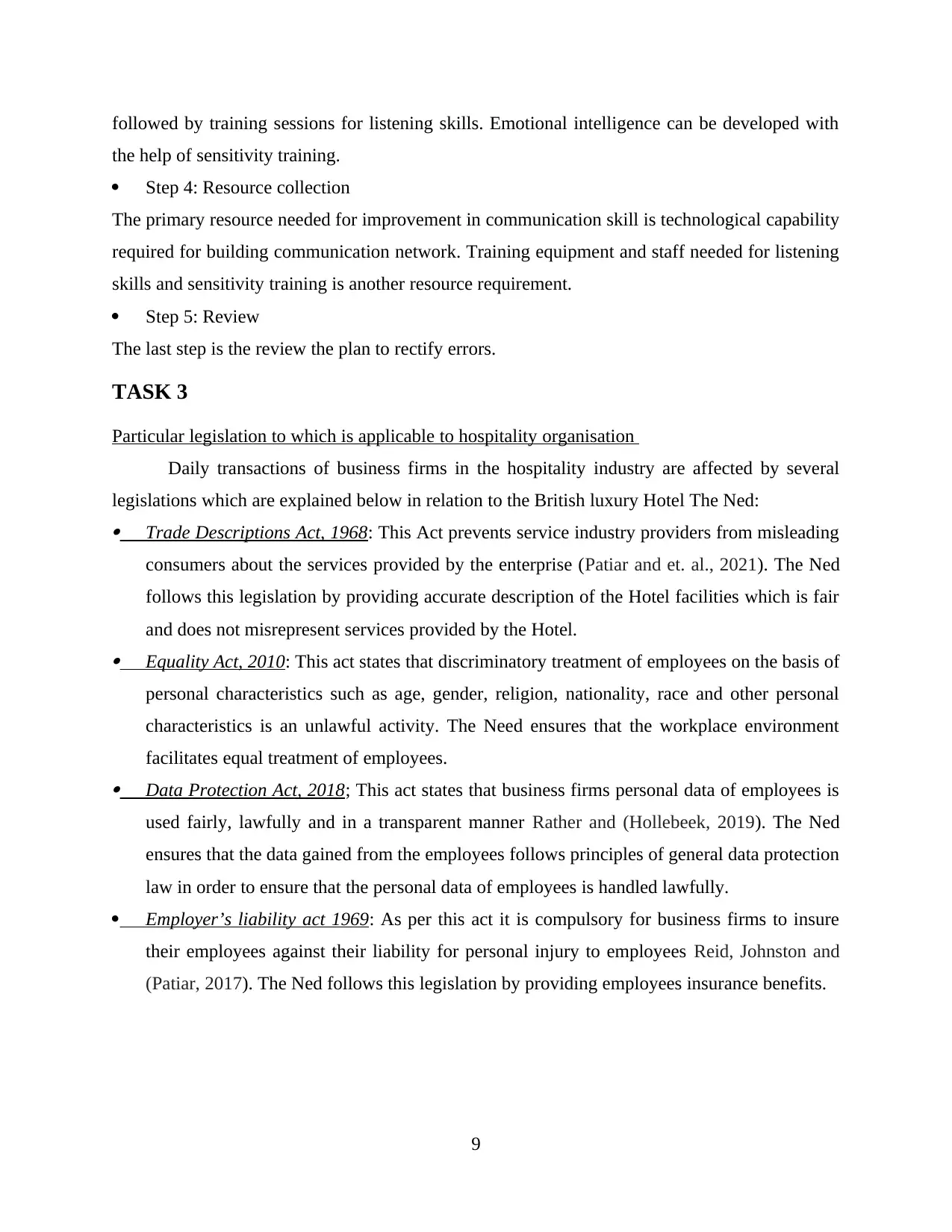
followed by training sessions for listening skills. Emotional intelligence can be developed with
the help of sensitivity training.
Step 4: Resource collection
The primary resource needed for improvement in communication skill is technological capability
required for building communication network. Training equipment and staff needed for listening
skills and sensitivity training is another resource requirement.
Step 5: Review
The last step is the review the plan to rectify errors.
TASK 3
Particular legislation to which is applicable to hospitality organisation
Daily transactions of business firms in the hospitality industry are affected by several
legislations which are explained below in relation to the British luxury Hotel The Ned: Trade Descriptions Act, 1968: This Act prevents service industry providers from misleading
consumers about the services provided by the enterprise (Patiar and et. al., 2021). The Ned
follows this legislation by providing accurate description of the Hotel facilities which is fair
and does not misrepresent services provided by the Hotel. Equality Act, 2010: This act states that discriminatory treatment of employees on the basis of
personal characteristics such as age, gender, religion, nationality, race and other personal
characteristics is an unlawful activity. The Need ensures that the workplace environment
facilitates equal treatment of employees. Data Protection Act, 2018; This act states that business firms personal data of employees is
used fairly, lawfully and in a transparent manner Rather and (Hollebeek, 2019). The Ned
ensures that the data gained from the employees follows principles of general data protection
law in order to ensure that the personal data of employees is handled lawfully.
Employer’s liability act 1969: As per this act it is compulsory for business firms to insure
their employees against their liability for personal injury to employees Reid, Johnston and
(Patiar, 2017). The Ned follows this legislation by providing employees insurance benefits.
9
the help of sensitivity training.
Step 4: Resource collection
The primary resource needed for improvement in communication skill is technological capability
required for building communication network. Training equipment and staff needed for listening
skills and sensitivity training is another resource requirement.
Step 5: Review
The last step is the review the plan to rectify errors.
TASK 3
Particular legislation to which is applicable to hospitality organisation
Daily transactions of business firms in the hospitality industry are affected by several
legislations which are explained below in relation to the British luxury Hotel The Ned: Trade Descriptions Act, 1968: This Act prevents service industry providers from misleading
consumers about the services provided by the enterprise (Patiar and et. al., 2021). The Ned
follows this legislation by providing accurate description of the Hotel facilities which is fair
and does not misrepresent services provided by the Hotel. Equality Act, 2010: This act states that discriminatory treatment of employees on the basis of
personal characteristics such as age, gender, religion, nationality, race and other personal
characteristics is an unlawful activity. The Need ensures that the workplace environment
facilitates equal treatment of employees. Data Protection Act, 2018; This act states that business firms personal data of employees is
used fairly, lawfully and in a transparent manner Rather and (Hollebeek, 2019). The Ned
ensures that the data gained from the employees follows principles of general data protection
law in order to ensure that the personal data of employees is handled lawfully.
Employer’s liability act 1969: As per this act it is compulsory for business firms to insure
their employees against their liability for personal injury to employees Reid, Johnston and
(Patiar, 2017). The Ned follows this legislation by providing employees insurance benefits.
9
⊘ This is a preview!⊘
Do you want full access?
Subscribe today to unlock all pages.

Trusted by 1+ million students worldwide
1 out of 18
Related Documents
Your All-in-One AI-Powered Toolkit for Academic Success.
+13062052269
info@desklib.com
Available 24*7 on WhatsApp / Email
![[object Object]](/_next/static/media/star-bottom.7253800d.svg)
Unlock your academic potential
Copyright © 2020–2025 A2Z Services. All Rights Reserved. Developed and managed by ZUCOL.



